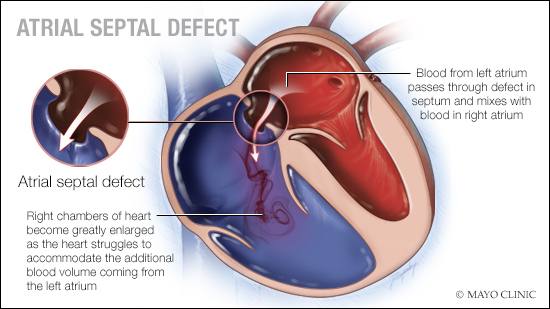-
Mayo Clinic Q and A: Follow-up care for children born with atrial septal defect
 DEAR MAYO CLINIC: My grandson was born with an atrial septal defect and already has had surgery. His health care provider says he shouldn’t have any lasting problems; yet, he’ll need to have regular checkups with a cardiologist until he is an adult. Why is this necessary? What will the cardiologist be looking for?
DEAR MAYO CLINIC: My grandson was born with an atrial septal defect and already has had surgery. His health care provider says he shouldn’t have any lasting problems; yet, he’ll need to have regular checkups with a cardiologist until he is an adult. Why is this necessary? What will the cardiologist be looking for?
ANSWER: There are several reasons why follow-up care is important for people born with an atrial septal defect. First, checkups are used to monitor heart function to ensure it returns to normal after the defect is repaired. Second, because infants who have this heart defect may be at an increased risk for developing other heart problems, follow-up appointments are an opportunity to catch any additional cardiac issues that may crop up.
An atrial septal defect is a hole in the wall between the atria — the two upper chambers of the heart. It’s a congenital condition, which means it is present when a baby is born.
An atrial septal defect disrupts the flow of blood through the heart. Usually, the right side of the heart moves blood to the lungs. In the lungs, blood picks up oxygen. The blood then returns to the heart’s left side, where it’s pumped to the rest of the body. An atrial septal defect allows oxygenated blood to flow from the left atrium into the right atrium. There, it mixes with deoxygenated blood and is pumped to the lungs again.
Some small atrial septal defects may not need treatment. When an atrial septal defect is larger, however, the extra blood it allows through the heart can overwork the heart’s right side. Eventually, that can cause the right side of the heart to enlarge and weaken. Over time, it also can increase blood pressure within the lungs and lead to pulmonary hypertension.
Symptoms of an atrial septal defect in infants may include shortness of breath; extreme sleepiness; swelling in the feet, legs or abdomen; low appetite; and inability to gain weight.
When atrial septal defects cause problems, a procedure to close the hole is necessary. For a smaller hole, a surgeon may be able to sew it closed. For larger atrial septal defects, a patch is placed over the opening between the atria. In the year after surgery, follow-up appointments typically include an echocardiogram to confirm that the patch remains in the proper position or monitor for leaks in the area where the atrial septal defect was sewn closed.
Some atrial septal defects can be closed without surgery by placing a device in the opening between the two atria. This device is deployed through a catheter going through the groin blood vessels into the heart. These devices require lifelong follow-up to ensure correct device position and make certain that the device is not interfering with surrounding structures.
Although symptoms of an atrial septal defect often disappear shortly after the hole is repaired, the heart doesn’t return to normal right away. It can take several years for the heart’s right side to recover completely from the blood volume overload caused by an atrial septal defect. Checkups during that time monitor how well the heart is working and check for any complications.
As time goes on, follow-up appointments become less frequent. By the time your grandson is a teenager, he may only need checkups about once every five years. Those checkups still are important, though. Even when they have successful treatment as children, as people born with an atrial septal defect age, they can be at higher risk for developing other heart concerns, particularly valve problems and atrial fibrillation. Consistent follow-up care can catch problems early when they are more easily treated.
For the most appropriate care once he becomes an adult, your grandson should consult a cardiologist who has formal training in adult congenital heart disease. That expert can develop a schedule of additional care that best suits your grandson’s medical circumstances.
The good news is that the outlook for children with congenital heart defects is bright. When treated promptly — and with consistent follow-up care — most people with these heart problems go on to enjoy a healthy future and have an excellent quality of life. — Dr. M. Yasir Qureshi, Pediatric Cardiology, Mayo Clinic, Rochester, Minnesota
Related Articles






